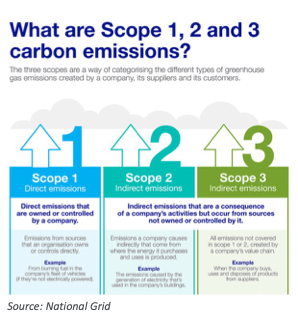RESOURCES
BLOG
Join in the community forum! The thINK blog is a place for community members to share their opinions, best practices, successes, and challenges. Add your comments to the blogs published here or write a blog and we’ll post it for you.

Carbon Emissions and Your Sustainability Strategy
Print service providers (PSPs) have been looking closely at electricity, natural gas, and any other fuels used in their operations as a step toward diminishing their use of carbon-based fuels. Many have also moved toward:
- Acquiring electricity from sources that are less dependent on carbon
- Installing solar panels onsite
- Purchasing renewable energy through their utility or a third party
These are all important steps, but they overlook one key point in regard to carbon footprint: We are all connected. If one of your suppliers has a heavy carbon footprint, this in turn impacts your own carbon footprint.
Scope 1, 2, and 3 Carbon Emissions
In the United States, the Securities and Exchange Commission (SEC) has proposed three levels in regard to reporting requirements for companies and their carbon emissions.

One of these levels (or scopes) is directly related to your business, while two others come indirectly from purchased goods or supply-chain emissions out of your control. Specifically:
- Scope 1 (direct): This category includes direct emissions produced by a company’s own facilities and vehicles. This may include, for example, the use of propane, liquefied petroleum gas (LPG), oil, kerosene, and non-energy-related greenhouse gasses.
- Scope 2 (indirect): These are emissions that a company causes indirectly from purchased goods and services. This includes energy purchased from a utility for heating or cooling, but also energy consumed in transportation, shipping, and business travel.
- Scope 3 (indirect): This includes emissions that you do not produce and are not the result of assets that you own or control. These are supply chain-related emissions (i.e., emissions from sources such as purchased goods and services, upstream transportation, and distribution) and encompass anything that is not within the Scope 1 and 2 categories.
Carbon Offsets and Renewable Energy Certificates
While bringing your carbon emissions down to zero is an admirable goal, the reality is that not all organizations will be able to do this in the short term. That is where carbon offsetting fits in. A carbon offset represents emission reductions outside your organization. It helps accelerate the goal of reducing emissions, and it also puts an identifiable price on the impact of carbon, which then provides an economic incentive to reduce emissions. Therefore, offsets do not represent a long-term solution, but they are a good method of moving toward climate neutrality.
Some PSPs offset the carbon footprint (particularly related to shipping) by purchasing Renewable Energy Certificates (RECs) to offset their carbon generation. Organizations like Carbonfund.org help businesses facilitate the purchase of carbon credits. The idea, in a nutshell, is to reduce your carbon footprint by reducing your energy use as much as possible and to offset the rest through the purchase of RECs. A REC (pronounced “wreck”) represents “the property rights to the environmental, social, and other non-power attributes of renewable electricity generation.” In essence, a renewable energy site makes the energy, and you, by purchasing the associated RECs (in quantities based on megawatt-hours of electricity) gain the property rights to that energy.
The Bottom Line
The first step toward a sustainability strategy is to measure your carbon footprint. You might consider resources like the Sustainable Green Printing Partnership and Green2Sustainable to help you through that process. It is vitally important to consider how the Source 1, 2, and 3 carbon emissions definitions apply to your operation and that of your supply chain partners.
The push is on. Sustainability should be a part of your journey today—don’t wait for national, state, or local regulations to force your hand. It’s all about ongoing improvements. As an added incentive, you can use the benefits of your sustainability efforts to your advantage in promotional efforts, client acquisition and retention, and workflow automation initiatives.
Want to make clear advances toward achieving your sustainability goals with inkjet? Join thINK for the upcoming thINK Academy live class Sustainability: It Is Everyone's Job on Tuesday, December 5, 2024.
Jim Hamilton of Green Harbor Publications is an industry analyst, market researcher, writer, and public speaker. For many years he was Group Director in charge of InfoTrends’ Production Digital Printing & Publishing consulting services. He has a BA in German from Amherst College and a Master’s in Printing Technology from the Rochester Institute of Technology.
